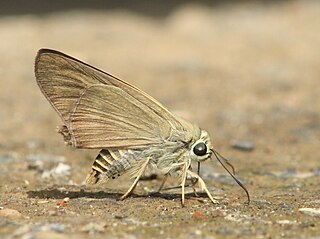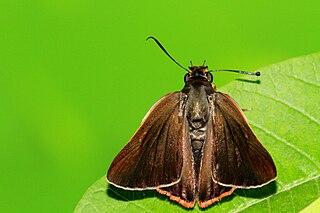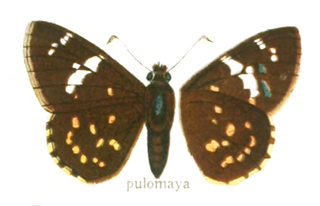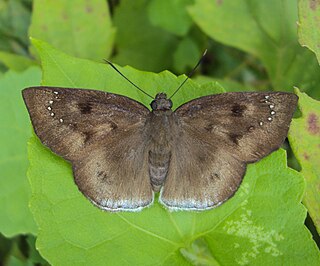
Badamia exclamationis, commonly known as the brown awl or narrow-winged awl, is a butterfly belonging to the family Hesperiidae. It is found in south and southeast Asia, Australia, and Oceania.

Bibasis gomata, commonly known as the pale green awlet, is a butterfly belonging to the family Hesperiidae. It is found in Northeast India, the Western Ghats and parts of Southeast Asia. The butterfly was reassigned to genus Burara by Vane-Wright and de Jong (2003) and is considered by them to be Burara gomata.

Burara jaina, the orange awlet, is a species of hesperid butterfly found in Asia. The butterfly was reassigned to the genus Burara by Vane-Wright and de Jong (2003), and is considered Burara jaina by them.

Bibasis sena, commonly known as the orange-tailed awlet, is a butterfly belonging to the family Hesperiidae, the skippers. It is also sometimes called the pale green awlet though that name can also refer to Bibasis gomata.

Hasora badra, the common awl, is a butterfly belonging to the family Hesperiidae, which is found in India.

Cupitha purreea, commonly known as the wax dart, is a butterfly belonging to the family Hesperiidae and only species of the genus Cupitha.

Iambrix salsala, the chestnut bob, is a butterfly belonging to the family Hesperiidae, that is found in parts of South Asia and Southeast Asia.

Taractrocera ceramas, commonly known as the Tamil grass dart, is a butterfly belonging to the family Hesperiidae. It is found from the Western Ghats to Mumbai, in the hills of southern India, in northeast India to northern Burma and in south-eastern China.

Celaenorrhinus pulomaya, the multi-spotted flat, is a hesperiid butterfly which is found in Asia.

Gerosis bhagava, the common yellow-breast flat, is a butterfly belonging to the family Hesperiidae. The species was first described by Frederic Moore in 1865.

Tagiades gana, the immaculate snow flat, large snow flat or suffused snow flat, is a butterfly belonging to the family Hesperiidae found in Indomalayan realm.

Bibasis harisa, the orange awlet, is a species of hesperid found in Asia. The butterfly was reassigned to genus Burara by Vane-Wright and de Jong (2003) and is considered by them to be Burara harisa.

Bibasis anadi, the plain orange awlet, is a species of hesperid butterfly found in India and Southeast Asia. The butterfly has been reassigned by Vane-Wright and de Jong (2003) to the genus Burara and is considered by them Burara anadi.

Bibasis vasutana, the green awlet, is a species of hesperid butterfly found in Asia. The butterfly was reassigned to genus Burara by Vane-Wright and de Jong (2003) and is considered by them to be Burara vasutana.

Burara amara, the small green awlet, is a species of hesperid butterfly found in Northeast India and Southeast Asia. The butterfly has been reassigned to the genus Burara by Vane-Wright and de Jong (2003) and is now Burara amara.

Bibasis oedipodea, the branded orange awlet, is a species of hesperid butterfly found in South Asia and Southeast Asia. The butterfly was reassigned to the genus Burara by Vane-Wright and de Jong (2003) and is considered by them to be Burara oedipodea.

Hasora anura, the slate awl, is a species of hesperid butterfly found in Asia. In India it is found in Sikkim and the Khasi Hills.

Capila zennara, commonly known as the pale striped dawnfly, is a species of hesperid butterfly found in tropical Asia.

Capila lidderdali, also known as Lidderdale's dawnfly, is a species of hesperid butterfly found in India and Southeast Asia.

Capila penicillatum, commomly known as the fringed dawnfly, is a species of hesperid butterfly found in India and Southeast Asia.




















